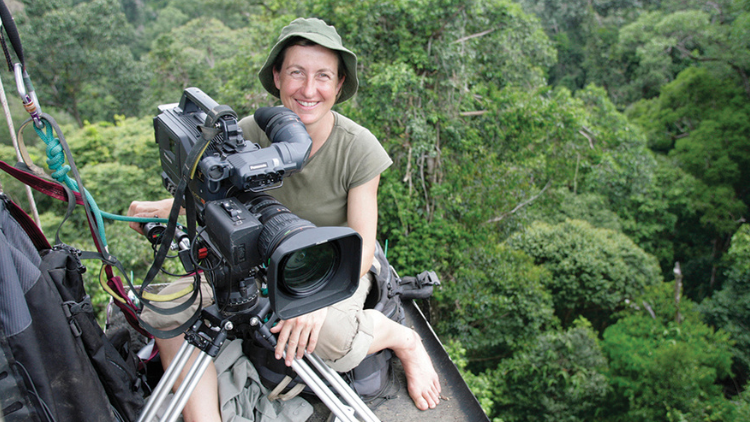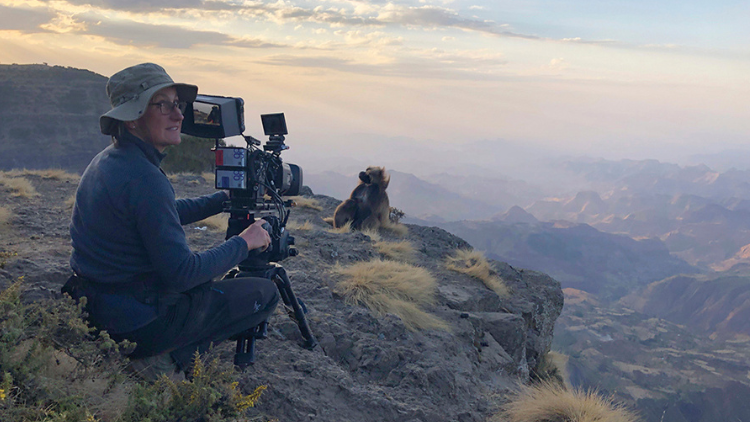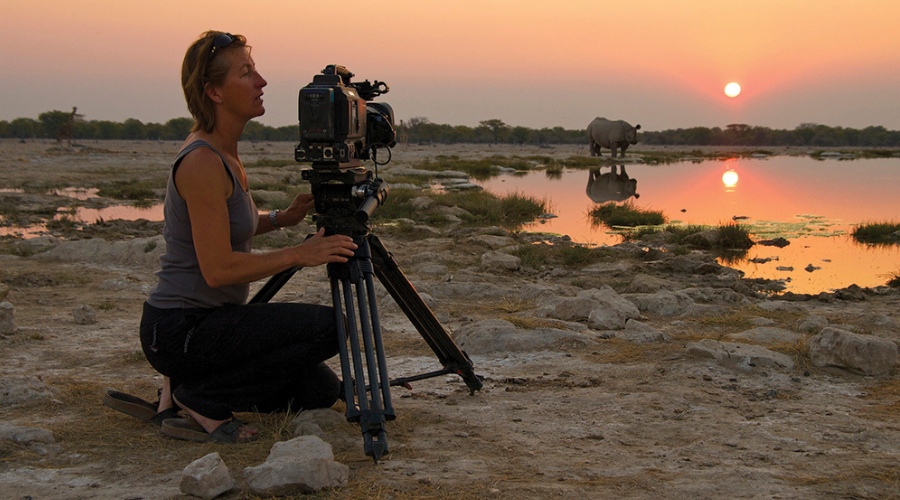Harrison Bennett talks to Justine Evans, the natural history film-maker and RTS Outstanding Contribution Award winner.
Wildlife film-maker Justine Evans recently had a friend visit her home near the Forest of Dean. As night fell, Evans took them mountain biking through the forest trails, which she regularly does with her wolfdog for no other reason than “it’s quite fun doing it in the dark”.
While they were out night riding, Evans recalls her friend turning to her and saying, “Oh, it’s not all that spooky, is it?”
“It was really weird hearing the word ‘spooky’, because it never occurred to me that being in the forest like that, in the dark, was spooky. When I’m in nature, I feel safe and nurtured.
“Cities, however, a completely different kettle of fish!”
It’s probably a useful mindset to have when it’s your job to track down and film animals, many of whom might sit far above us in the food chain. Then again, simply listening to Evans joyfully recount some of her many experiences of profound natural beauty may leave you feeling the same way.
She’ll tell you of sleepovers in the rainforest canopy in Borneo while filming gibbons for Expedition Borneo (2007), and waking up to their dawn chorus. Or of filming rhinos (who are typically solitary by day) socialising at a Kalahari waterhole in the moonlight for Africa (2013) – behaviour that had never been recorded before.
And even the more brutal stories inspire a sense of existential awe. Evans once filmed a notorious, elephant-predating pride of lions in Botswana as they ate an adolescent alive. It was another “first”, this time for Planet Earth (2006), but at one point she had to turn her camera off.
“I was only filming things that were not too graphic,” she explains. She also had to take a moment: “I remember looking up at this amazing starscape in the sky and thinking, ‘It’s all OK, this is just life going on.’”
After half an hour, convinced that the elephant must have died, she turned her camera back on. But when she looked through the viewfinder, she saw one of the lions lick the elephant across his eyeball, “and the eyeball flinched”.
“That was traumatic,” she admits. But when I ask if these moments of brutality have ever put her off the job, her answer is a resounding “No!”.
“Because then you’d be a complete hypocrite,” she explains. “The brutality we cause our world is off the scale.” You can’t really argue with that, and yet I still think it takes an increasingly rare connection to nature to continue to feel “safe” in the wild.
Evans calls it a “predisposition”. She grew up in Kingston upon Thames in Surrey on a road that leads into Richmond Park and, right through to her teen years, she was spending most of her time wandering its ancient woods and rolling hills, including many nights seeking out the local hedgehogs, badgers and deer. “There was a lot of strife going on in the family home, so, for me, it was a way of connecting to something nurturing.”
By age 11, she was marching against the clubbing of harp seals and knocking on doors for donations to the Animal Liberation Front. At 18, her long-time obsession with tigers was sending her all the way to India in search of one.

It was on that trip to India that the idea of film-making first popped into her head. After finding a job “vaguely related to media” with a company that ran a reference library for TV ads, she secured a spot on a drama-dominated film-making course at Bournemouth Film School. There were no natural history options back then, but the course had the unexpected virtue of being located in Dorset’s lowland heathland, the only habitat of its kind in the UK.
With the habitat under threat, the Royal Society for the Protection of Birds (RSPB) came to the School calling for a campaign film on some of its rare species. Evans had made her interests quite clear, so the head knew exactly the person to ask.
The RSPB was so happy with her film that, once Evans left film school, it commissioned her to do another on the illegal wild bird trade. Working with another film-maker, Sarah Cameron, she chose to investigate the Moluccan cockatoo, a CITES Appendix 1 protected parrot that is found only on a few islands in Indonesia, yet was somehow finding its way to markets in Europe. “And so we went off to Seram Island undercover, because we couldn’t say we were from the RSPB. But we were really shit at lying. I think we might have said we were from the BBC!”
In fact, it wasn’t to be the BBC that gave Evans her big break, but Sean Morris, a founder of Oxford Scientific Films, when he asked her to film the lifecycle of a neotropical tree in Panama for National Geographic.
She still remembers filming in the canopy for the first time, “and just thinking that was the most beautiful place I’d ever been, and, ‘This is it, I just want to stay up here for the rest of my life’.”
That was the first principal camera work Evans had been given; work that, for women, can be hard to come by. Even after completing the Panama film, Evans found it difficult to find more. She remembers that, back then, when asking the BBC for work, “there was always a reason why you weren’t quite good enough. There was never this energy of, ‘Let’s help you go forward’. I remember finding that quite confidence-eroding.”
Around the time we speak, the Wildlife Camerawomen Community had gathered some stark statistics demonstrating the genre’s still overwhelming gender disparity in cinematography roles. The data sampled the latest blue-chip series from multiple companies, including the BBC, Wildstar Films, Plimsoll Productions and Silverback Films.
Planet Earth III, for example, used 87 male and just four female cinematographers. One of whom was Evans, who filmed one of the series’s most devastating sequences, of a mother elephant forced to abandon her son to death by dehydration in a drought-stricken Kenyan desert.

You would think such extraordinary footage, shot by Evans and the few other women working in wildlife cinematography, would put paid to the sexist mistrust. If not, then maybe the Outstanding Contribution Award Evans took home at the 2023 RTS Craft & Design Awards for her 30-plus years of film-making will.
Evans does think there is more awareness of the issue now. In March, for example, the new National Geographic and Wildstar Films series Queens will thrust the issue on to a global stage. Evans served as joint series director with Sophie Darlington, and they both mentored some of the younger women involved. “It’s basically a female-led production about powerful female leaders in the natural world,” she says. “A very long time coming.”
In terms of sheer patience, though, the job does call for a certain type of person; nature doesn’t just play the hits. “I wouldn’t say it’s a breeze, for example, going out every day before light, sometimes hiking quite a long way before you even get on to the ropes to climb up a tree. Then you’re sat on a platform of not much more than a metre square for 10 hours or so, bathing in sweat. And sometimes nothing happens.”
In those situations, says Evans, you sometimes have to adapt the narrative. While in Romania to film its elusive bears and wolves for Transylvania: Living with Predators (2001), for example, they were proving rather too elusive, so Evans shifted her focus to the shepherds she was camping with in the Carpathian Mountains, and their traditional way of life.
One of the shepherds gifted Evans one of her most treasured possessions: a hazel-wood shepherd’s staff, which he had carved with scenes of flowers and little houses. “That’s the only thing they have to protect their livestock and themselves with.
“They’ll sort of biff a bear on the head with it when trying to retrieve a sheep that the bear has taken. But it’s just a stick!
“So many of them have had chunks taken out of their legs where bears have bitten them. One guy had holes in his head where a bear had dragged him by his head across the meadow.”
"There was only one time where I thought ‘Yeah, that’s it, I’m probably going to die"
After all this unflinching talk of elephant-eating lions and shepherd-biting bears, I was wondering if Evans might ever have feared for her life. “Surprisingly few times,” she says. “There was only one time where I thought, ‘Yeah, that’s it, I’m probably going to die’.”
In 2003, she was tracking elephants for a BBC Natural World through a thick bamboo forest in Mount Elgon National Park, with two rangers from the Kenyan Wildlife Service (KWS). They suddenly stumbled upon two females and their young, who were unexpectedly away from the rest of the herd. One of the females sensed them and started charging – “She really meant it, she was furious”– and Evans still remembers the sound of the bamboo exploding behind her as she ran.
Until she tripped over.
Luckily, Daniel, one of the KWS rangers, had managed to run ahead and hide behind a tree. “He was pointing his gun over my head ready to shoot this poor elephant.” Somehow, however, she managed to pick herself up and throw herself down behind him. The elephant got confused and ran off unharmed.
It’s a gripping story, but Evans rightly points out that, by asking such a question, I am only buying into what she calls the “Hollywood” view of nature, that it is somehow “out to get you”. After all, the elephant was only trying to protect its young calf.
Because, if Evans has a guiding ethos, it is to instil that same feeling of nature-as-nurture that she has felt ever since those hedgehog-seeking nights in Richmond Park. And, as the climate crisis and the extinctions ramp up, it has become urgent work.
“The natural world is not out to get us,” she says, “it is actually a place that we fit into, and should have an emotional connection with.”





